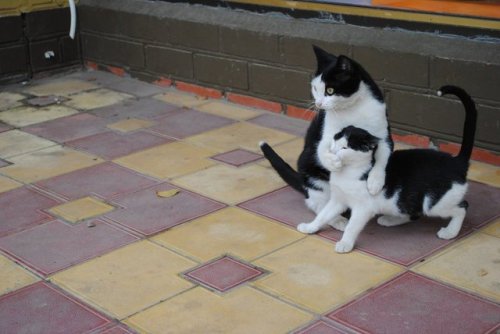Anisomorpha - Wiems

More Posts from Anisomorpha and Others

^ for the unaware
REBLOG if you have amazing talented artist friends!

The final stage of every OC's creation is having to go through websites like this to name it:


words cannot sum up my love for neil shubin
Scanning electron microscopy is awesome and I personally think the images it produces are gorgeous but objectively speaking I feel like it doesn't do any favors at all for the "scary" cultural image of insects, because I mean, here's a closeup of a carpet beetle in its true colors:

And here's an SEM image that comes up for carpet beetles on google:

And the thing about SEM images is that they aren't "photographs;" they are computer scans. They're 3-d digital models generated by scanning an object at the molecular level. Color is not preserved by this process, and if it were all the specimens would look like metal anyway (I'll explain this is in a moment), so images like this had to be colored artificially. This isn't done to recreate the true colors, but to make different body parts more visible as study material, resulting in scientific images of wacky blueberry fleas:

The subtly varying transparency levels of living tissues are completely lost as well, which is why the fine hairs of insects stand out more like cactus thorns in SEM imagery, and tardigrades look like opaque leathery things with no eyes:

...Even though a tardigrade actually has eyes, they're just under the surface of a crystal clear exoskeleton:

Another thing that probably contributes to the uncanniness of SEM images is also the fact that they can only show us embalmed corpses encased in liquid metal.

It's not possible to do this fine level of scanning "instantaneously" enough for it to work on anything that's still moving, so even when you see scanning electron images of animals in various lifelike poses, it's because they're preserved specimens that were carefully positioned, or they were live specimens basically "flash frozen" by a sudden dehydration process, mummified so fast they never knew it. Many specimens are then "sputter coated," meaning they're sprayed with a thin (like microns thin) layer of liquid gold, platinum or other fine metal in order for the electrons to perfectly bounce off of every subatomic detail and produce that perfect scan. So this is a live fruit fly:

And this is a fruit fly mummy with probably some sort of chrome plating:


Eastern Hellbender, 2024
Found throughout the Eastern US, especially in western North Carolina and the Appalachian Mountains, these adorable big salamanders rely on large, flat rocks in streams for shelter and breeding. Hikers removing or stacking rocks from the streams pose a big problem for these guys, so if you see a man-made rock stack always take it down!

I’m terribly sorry, madam. I have absolutely no idea where he learned that word.
The artist Paweł Ponichtera seems to have inexplicably dedicated a massive amount of time and effort to hyper-detailed and hyper-accurate illustrations of chinchillas engaged in historical fencing, many with clear and specific reference to particular historical treatises. So, I give you:

Hans Talhoffer Chinchillas

Harnisfechten Chinchillas

Joachim Meyer Longsword Chinchillas

Fantastical Snail Marginalia Chinchillas

Olympic Epee Chinchillas

Salvator Fabris Rapier-in-the-Nude Chinchillas

Napoleonic Saber Chinchillas

Arabic Shamshir Chinchillas

18th Century Smallsword Chinchillas

I.33 Sword and Buckler Chinchillas


![A tweet by Emily Taylor @snakeymama that shows a screenshot of a cartoon rattlesnake in the foreground looking at a crouching FedEx driver in front of his truck in the background. The accompanying text says “You can see the commercial “Porch Protector” here [partial URL follows] 2/ 4
A second tweet by Emily below that reads “You can help by reposting this or by emailing to express your concern about the commercial: MediaRelations@fedex.com and to the CEO at FWSmith@fedex.com 3/4”](https://64.media.tumblr.com/ce39f1a89c31ae2bed3a5c8671777bc3/ece42ab741223248-36/s500x750/707e20523ff81d933d71e3720cc7ea30810115a9.png)


So--long story short, a FedEx driver killed a rattlesnake that happened to be on someone's porch, not causing any immediate problems. This is an all too common practice here in the United States, where a significant portion of the population has the backwards idea that "the only good snake is a dead snake" and that the only way to deal with a venomous snake in the proximity of a house, or people in general, is to kill it. Never mind that snakes tend to move on if left alone, and that there are numerous entities that can be contacted to move the snake safely to another place if so desired, and that most bites occur when someone is harassing, handling, or trying to kill the snake.
Dr. Emily Taylor of California Polytechnic State University (@snakeymama on Twitter) has requested that people contact FedEx about their recent commercial glorifying the killing of the snake, which you can view here. I've included both her and my letters to the appropriate folks at FedEx. There are options for both email and snail mail correspondence, and the more people FedEx hears from about this appalling matter, the better.
It's 2024, almost 2025. We have tons of information on rattlesnake behavior and best practices in coexisting with them (to include training your dogs in snake avoidance). We know plenty about the importance they have in local ecosystems, and the devastation that has been done through people slaughtering them, sometimes in the thousands (I wrote about the ongoing problem of rattlesnake roundups and their inherent cruelty here.) There are multiple rattlesnake species that are endangered or otherwise threatened with extinction.
The vast majority of encounters with venomous snakes are benign, and the vast majority of bites come from someone (person, dog, etc.) confronting the snake that was just trying to defend itself. We've spent a lot of time in this country defaulting to killing anything that inconveniences us, but there are better ways to live safely in proximity to wildlife that don't involve violence. It just takes a little more effort and awareness, and most importantly a significant attitude change that no longer vilifies native wildlife simply trying to live their lives.
As Dr. Taylor mentioned, if you want to contact FedEx, here are your options:
"You can help by reposting this or by emailing to express your concern about the commercial: mediarelations@fedex.com and to the CEO at FWSmith@fedex.com. Or send letters to: Fred Smith, CEO Brie Carere, Executive Vice President and Chief Customer Officer Ryan Kelly, Vice President of Marketing FedEx Corporation 942 South Shady Grove Road Memphis, TN 38120 USA"
-
 peony-pipebomb liked this · 2 months ago
peony-pipebomb liked this · 2 months ago -
 aurinsf liked this · 2 months ago
aurinsf liked this · 2 months ago -
 fr00gyx3 liked this · 2 months ago
fr00gyx3 liked this · 2 months ago -
 caffeinated-object liked this · 2 months ago
caffeinated-object liked this · 2 months ago -
 a-queer-child-of-chaos reblogged this · 2 months ago
a-queer-child-of-chaos reblogged this · 2 months ago -
 yoza22 reblogged this · 2 months ago
yoza22 reblogged this · 2 months ago -
 yoza22 liked this · 2 months ago
yoza22 liked this · 2 months ago -
 spaghettihell reblogged this · 2 months ago
spaghettihell reblogged this · 2 months ago -
 arachnidsgoth liked this · 2 months ago
arachnidsgoth liked this · 2 months ago -
 geodethecrow liked this · 2 months ago
geodethecrow liked this · 2 months ago -
 afriendofblahaj reblogged this · 2 months ago
afriendofblahaj reblogged this · 2 months ago -
 eightglass reblogged this · 2 months ago
eightglass reblogged this · 2 months ago -
 eightglass liked this · 2 months ago
eightglass liked this · 2 months ago -
 afriendofblahaj reblogged this · 2 months ago
afriendofblahaj reblogged this · 2 months ago -
 ieatwalls404 reblogged this · 2 months ago
ieatwalls404 reblogged this · 2 months ago -
 omegaspoon3141 reblogged this · 2 months ago
omegaspoon3141 reblogged this · 2 months ago -
 omegaspoon3141 liked this · 2 months ago
omegaspoon3141 liked this · 2 months ago -
 scarecrowwannabe liked this · 2 months ago
scarecrowwannabe liked this · 2 months ago -
 shorttrans reblogged this · 2 months ago
shorttrans reblogged this · 2 months ago -
 shorttrans liked this · 2 months ago
shorttrans liked this · 2 months ago -
 availableclimate reblogged this · 2 months ago
availableclimate reblogged this · 2 months ago -
 availableclimate liked this · 2 months ago
availableclimate liked this · 2 months ago -
 thelovegiver-again liked this · 2 months ago
thelovegiver-again liked this · 2 months ago -
 crows-junk-pile reblogged this · 2 months ago
crows-junk-pile reblogged this · 2 months ago -
 give-liife liked this · 2 months ago
give-liife liked this · 2 months ago -
 chaos-triangle liked this · 2 months ago
chaos-triangle liked this · 2 months ago -
 accidentallyoccidental reblogged this · 2 months ago
accidentallyoccidental reblogged this · 2 months ago -
 the-silliest-being reblogged this · 2 months ago
the-silliest-being reblogged this · 2 months ago -
 the-silliest-being liked this · 2 months ago
the-silliest-being liked this · 2 months ago -
 garmrin reblogged this · 2 months ago
garmrin reblogged this · 2 months ago -
 homocidalpotat reblogged this · 2 months ago
homocidalpotat reblogged this · 2 months ago -
 poppycatevergreen liked this · 2 months ago
poppycatevergreen liked this · 2 months ago -
 onionjuggler reblogged this · 2 months ago
onionjuggler reblogged this · 2 months ago -
 cosmicdreamswiper liked this · 2 months ago
cosmicdreamswiper liked this · 2 months ago -
 vkr-kayne reblogged this · 2 months ago
vkr-kayne reblogged this · 2 months ago -
 pterostar liked this · 2 months ago
pterostar liked this · 2 months ago -
 winterrssoldier liked this · 2 months ago
winterrssoldier liked this · 2 months ago -
 butchconnoisseur reblogged this · 2 months ago
butchconnoisseur reblogged this · 2 months ago -
 tea-kettle-tea-kettle liked this · 2 months ago
tea-kettle-tea-kettle liked this · 2 months ago -
 faery-berry-blast reblogged this · 2 months ago
faery-berry-blast reblogged this · 2 months ago -
 jinxstinx reblogged this · 2 months ago
jinxstinx reblogged this · 2 months ago -
 empressluxuria liked this · 2 months ago
empressluxuria liked this · 2 months ago -
 stellaanneblog reblogged this · 2 months ago
stellaanneblog reblogged this · 2 months ago -
 pocketwatchcrow liked this · 2 months ago
pocketwatchcrow liked this · 2 months ago -
 sillyjewishbug liked this · 2 months ago
sillyjewishbug liked this · 2 months ago -
 lifeandallwithinit liked this · 2 months ago
lifeandallwithinit liked this · 2 months ago -
 dailybugbox reblogged this · 2 months ago
dailybugbox reblogged this · 2 months ago -
 mothable reblogged this · 2 months ago
mothable reblogged this · 2 months ago

Art blog @morganwiemerart | she/her, 23 | Reblog interesting creatures and personal stuff here
296 posts












